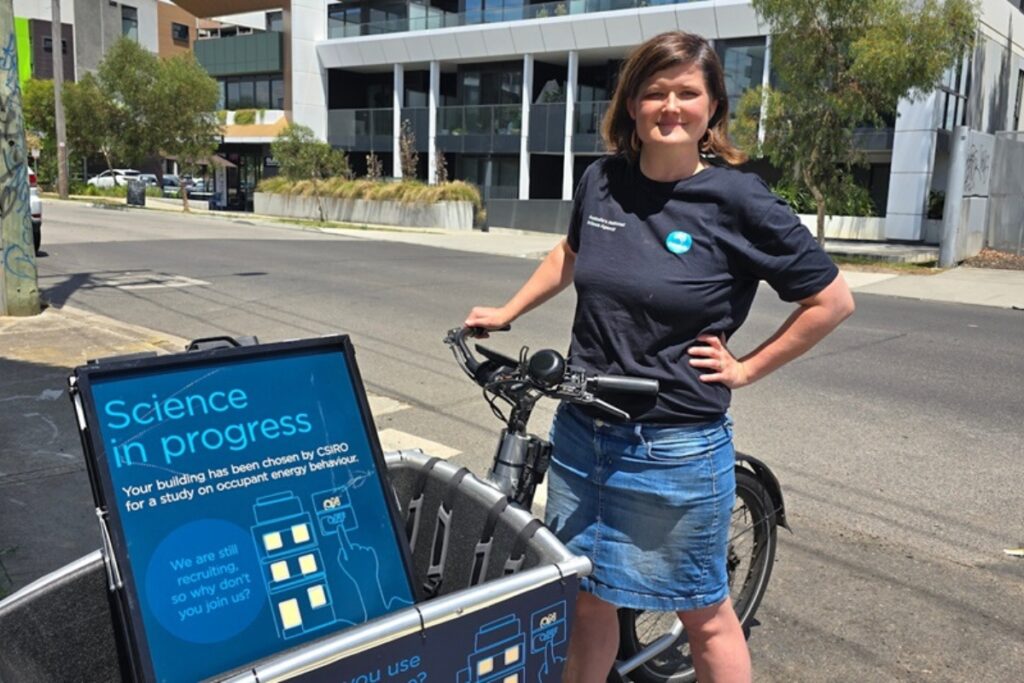This article is about how strata owners can help CSIRO research Australian home energy use to inform net-zero goals.
Key points
- Two CSIRO studies are providing a more complete picture on how modern Australians use energy at home, opening the potential to shape policy, research and construction as we move towards net zero.
- Dr Pippa Soccio is investigating how Australians living in apartments use energy in a two-year study that will track indoor environmental conditions and behaviour.
- Mr Michael Ambrose is testing a methodology that would see the nation’s energy efficiency ratings for new homes expanded to existing homes.
As Australia moves towards a target of net zero carbon emissions by 2050, our researchers are working to fill a big missing piece of the puzzle – existing houses and apartments.
The Nationwide House Energy Rating Scheme (NatHERS) provides clear standards for the construction of new dwellings. Now, Michael Ambrose and team are testing a method that would allow the scheme to be applied to existing homes built prior to the introduction of NatHERS.
Meanwhile, Dr Pippa Soccio is undertaking Australia’s largest-ever investigation of the energy use of people living in apartments, a group that has been traditionally neglected in energy studies.
Both scientists have had to overcome unexpected challenges to advance these projects to being tested in Australian homes. Some of these challenges have their roots in the 1940s, while others are very modern.
Powering through challenges
Pippa said the origin for energy efficiency models is detached housing in the 1950s, when scientists from CSIRO’s Division of Building Research Laboratory started investigating the influence of climate on buildings. Several assumptions were made back then about how people live.
“For example, I found that the heat gain schedule used in the model assumes a household will start cooking an evening meal at 4pm using heat-intensive activities like using the oven, grilling and frying,” Pippa said.
“This doesn’t account for changes in behaviour over the past 80 years, especially in apartments, which may not have a big enough oven to cook a roast or even feature an oven at all.”
With a growing number of people living in apartments – they are now the dominant form of new dwelling being constructed in New South Wales – the time is ripe to understand their energy use.
The Apartment Energy Behaviour Study involves monitoring actual energy usage over a period of two years, via a device placed into participants’ apartments that shares data with the researchers.
This might sound straightforward, but it has thrown up numerous, often-unexpected, logistical challenges.
The devices needed to be:
- easy to install
- aesthetically pleasing, or at least neutral
- designed to minimise electrical cords to avoid the risk of being unplugged
- capable of collecting accurate data that can be accessed remotely.
To identify a suitable device, Pippa set up a testing wall at home in her living room, where she tested different devices to determine which would work best for this project.

The end result is a kit Pippa refers to as a “CSIRO show bag”, full of everything an installer might need.
Procuring enough devices for 430 apartments led to hundreds of boxes (weighing 1.4 tonne) being delivered to CSIRO, and the team needing two weeks just to unbox them all!
Then there have been the challenges in recruitment, including a very modern problem.
Participation in the Apartment Behaviour Energy Study is targeted so Pippa can control for variables in apartment design and construction.
After identifying appropriate buildings, she then wrote to occupants inviting them to take part with a personalised, hand-written letter and a postcard with links and QR codes to more information.
People thought it was a scam.
“Because it’s so customised and bespoke and very much about trying to target people to make them feel special, it’s had the opposite effect, because it doesn’t look like what they expect from CSIRO,” Pippa said.
She is working to overcome this problem by placing sandwich boards outside target buildings, and identifying champions within the building who can reassure and recruit neighbours.

Shining new light on energy efficiency in homes
While Michael hasn’t faced the same recruitment challenges as Pippa, he has had to go through the same challenge of developing new methodologies for his NatHERS Existing Homes Trial.
“New homes have a full set of documentation that allows an energy assessment, but collecting this information for existing homes was traditionally very laborious and involved someone measuring the whole house with a tape measure or using a $40,000 laser scanner,” Michael said.
“But if we’re going to make energy efficiency a mandatory disclosure, the rating process needs to be quick, cost-effective and accurate.”

Michael is taking advantage of new laser scanning technology that can be accessed from an iPad and allows an assessor to scan an entire double-storey home in 20 minutes, then import that data into modelling software. It’s an advance he describes as ‘game-changing’.
“Even on new homes with documentation, we would have to manually input that data into the modelling software, so to have that happen automatically streamlines the process even further,” Michael said.
The end result for homeowners will be a trial certificate on the energy efficiency of their home, and recommended upgrades to improve the rating, while the researchers will discover whether their methodology can be rolled out at scale.
Another stream of this project involves banks interested in assessing the energy performance of their mortgage portfolios. This could support environmental reporting and create opportunities to offer customers discounted interest rates for more energy-efficient homes.
“This bank stream piggybacks on the existing valuation process, whereby valuers collect the information needed, then energy assessors rate the property and provide that information to the bank,” Michael said.
The future of residential energy use
The benefits of the two projects stand to stretch well beyond their original goals of understanding energy use in apartments and testing a method for expanding energy efficiency ratings to existing homes.
“These projects represent a golden opportunity to generate rich data sets that researchers haven’t had access to in the past,” Michael said.
“There is going to be a lot of research work enabled by this data, such as modelling the use of AI algorithms in household energy, then testing those models in actual homes.”
The future of residential energy efficiency in Australia is bright.
Amanda Dunne and Bronwyn Adams
CSIRO
E: [email protected]
This post appears in Strata News #738.
This article has been republished with permission from the author and first appeared on the CSIRO website.
Have a question or something to add to the article? Leave a comment below.
Read Next:
- NSW: Sustainability infrastructure: What is it & how has installing it been made easier?
- NSW: Q&A Solar for Apartments – Power to the (Strata) People
- VIC: Q&A Embedded Networks, Common Power & Smart Meters
Visit our Apartment Living Sustainability OR state-specific strata information pages.
Looking for strata information concerning your state? For state-specific strata information, take a look here.
After a free PDF of this article? Log into your existing LookUpStrata Account to download the printable file. Not a member? Simple – join for free on our Registration page.


Leave a Reply